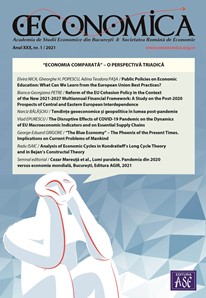
Romania’s Public Debt Relative to GDP – Implications
The public debt officially measured by the Romanian Ministry of Finance based on the European methodology advanced, in July 2020 alone, almost as much as in the whole second quarter, when Romania was caught in the middle of the pandemic-induced crisis shock and the quarterly GDP decreased by 12.3% compared to the previous quarter. The explanation for the relative increase as a public debt share of GDP (2.1 percentage points in Q2 and 2 pp in just one month, July 2020) is not limited to the increase by about 40% of the additional monthly borrowed amounts (RON 13.5 billion compared to the monthly average of 9.7 billion in full pandemic), but also in the reduction of the reporting base by over RON 20 billion (approx. EUR 4.1 billion) as a result of the methodology used.
According to the EU methodology, the debt share of GDP during the year is calculated by relating the balance to the total of GDPs achieved in the last four quarters. In order to obtain the new denominator for the fraction that shows us the public debt as a percentage, the result for Q2 2019 was subtracted from the GDP used for the denominator and replaced with the result for Q2 2020. Thus, from the previous value of RON 1,072,848.4 million, we reached to RON 1,052,040.5 million. This is because, in the second quarter of the year, the GDP loss was almost RON 21 billion. This reduction in GDP in nominal terms fully contributed in July to the result of additional percentages of public debt, beyond the additional almost EUR 3 billion already borrowed (compared to the money needed for the debt “rollover”) before the increase of pensions and child allowances.
In other words, if we also consider maintaining the salary increase program in the budgetary sector, available data suggest that state expenditures have been committed beyond possibilities. The deficit limit was already reset to 8.6% of GDP. But, if RON 91 billion is for sure within the negative range, it is less clear how we can obtain, after a result of RON 440 billion in Q1, the difference of RON 618 billion in Q2, which remained to be achieved until reaching the estimated yearly GDP of RON 1,058 billion (lower than in 2019, even in nominal terms).
So, we have come to the point where GDP is clearly going down and the expenditures committed, even if cut, are going even more visibly up. To make a bitter joke in the sports field, “whether you have the ball or not, you short for the goals”. However, at a debt of more than 40% of GDP and an average level of about 3.75% of interest paid (it was 3.36% on September 15th, but only the quotation to date, as the average is also calculated with the amounts already borrowed), half (1.5%) of the 3% deficit gap allowed by the Maastricht criteria is already gone in the long-term.
To be clear, half of the money accepted for the deficit is already blocked by previous budgetary engagements. That in context of a systematic external deficit of 7% – 8% of GDP recorded annually in goods trade. We can still make some deficit either for additional consumption, implicitly increased foreign deficit, or for investments, if we do not want to throw away money, partly for the benefit of other economies.
Anyway, we will set the bill heavily and in the long run for future generations, who will have to pay significant percentages of GDP year after year and so on (without any tangible compensation in schools, hospitals or roads) due to the competence and character of their forefathers.
P.S. The public debt has exceeded the threshold of RON 500 billion, according to national accounts. In fact, the level of public debt officially calculated by the Ministry of Finance exceeded in July 2020 the threshold of RON 500 billion in the national accounts (OUG 64/2007 includes guarantees issued by central and local authorities) but the value of RON 517.6 billion was adjusted after the consolidation based on the European accounting system to RON 444.4 billion. While the debt at the central administration level has increased since 2015 by two thirds, from slightly less than RON 300 billion to RON 501.9 billion in July 2020, the local debt decreased (!) from RON 16.8 billion to RON 15.9 billion, also in nominal terms.
Photo credit: needpix.com








